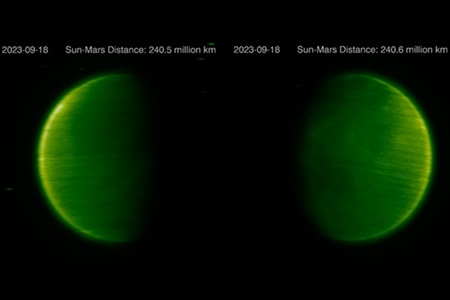EMM was formulated with three objectives that align with inquiries raised by the global assembly of Mars scientists and researchers, MEPAG - the Mars Exploration Programme Analysis Group.
 The Emirates Mars Mission (EMM), marking the first interplanetary exploration undertaken by an Arab nation, has unveiled a series of observations derived from the initial measurements of Mars atmosphere spanning a full Martian year (equivalent to two Earth years). This release commemorates the third year of scientific data collection around Mars by the Hope probe, marking the achievement of the Missions designated scientific goals.
The Emirates Mars Mission (EMM), marking the first interplanetary exploration undertaken by an Arab nation, has unveiled a series of observations derived from the initial measurements of Mars atmosphere spanning a full Martian year (equivalent to two Earth years). This release commemorates the third year of scientific data collection around Mars by the Hope probe, marking the achievement of the Missions designated scientific goals.
Salem Butti Al Qubaisi, Director General of UAE Space Agency, said: The Emirates Mars Mission was conceived to provide a national challenge that would accelerate the development not only of the UAEs engineering capabilities, but to disrupt our education, research and innovation ecosystems. There is no doubt at all that it has succeeded in that beyond our wildest expectations. At the outset, the UAEs leadership made it clear that EMM should make a significant scientific contribution and we can now say that the mission not only fulfilled its original science objectives, but has significantly surpassed them.
EMM was structured to achieve three objectives that complemented inquiries posed by the global community of Mars scientists and researchers, MEPAG – the Mars Exploration Programme Analysis Group. Hope aimed to monitor the global, diurnal, and seasonal changes in the Martian atmosphere due to year-to-year variations, including those caused by solar forcing resulting in atmospheric escape particularly of Hydrogen and Oxygen, and the temporal and spatial behaviour of Mars atmosphere.
Hoor Al Mazmi, EMM Project Manager, commented: We can say with confidence that EMM has blown past its original stated science objectives. Not only have we achieved our goals, and taken Hope into an extended mission, but we have added unique new discoveries, from investigations of new types of aurora through to the most extensive new observations of Mars least known moon, Deimos.
Mohsen Al Awadhi, Director of Space Missions Department at UAE Space Agency, stated: Hopes unique elliptical orbit supports these unique observations, giving us a near-complete picture of the planets atmospheric dynamics every nine days. That has enabled us to create an incredible depiction of Mars changing atmosphere day and night, across the seasons and throughout a full Martian year. With the probe performing optimally, we performed a manoeuvre to support a season of Deimos observations and I can say today that we still have the option, from an engineering point of view, of further extending the mission.
A series of visuals shared by the Emirates Mars Missions Science Team to celebrate the third anniversary include an animation of the Oxygen emission changing over more than one Martian year captured by its Emirates Mars Ultraviolet Spectrometer, EMUS. Acquired when the spacecraft passed over local times around 9 am and 3 pm, these images of atomic oxygen emission at a wavelength of 130.4 nm revealed the vigorous dynamics of the upper atmosphere of Mars, which is slowly escaping into space. The EMUS videos showed the variability of oxygen across the Martian year as the planet moves closer and further away from the sun. These global views of the oxygen emission have never been seen before this mission.
In addition to the EMUS animation, the EMM science team shared Emirates Mars Ultraviolet Spectrometer (EMIRS) images showing daily global maps that the instrument gets of dust and ice over a full Martian year, enabling analysis and better understanding of the daily variation of these constituents.
Finally, the science team has revealed Emirates Mars Ultraviolet Spectrometer (EXI) images that show how the planet changes visually using a sequence of 12 images taken across an entire Martian year exhibiting the impacts of seasonal change on the planet.
















































































